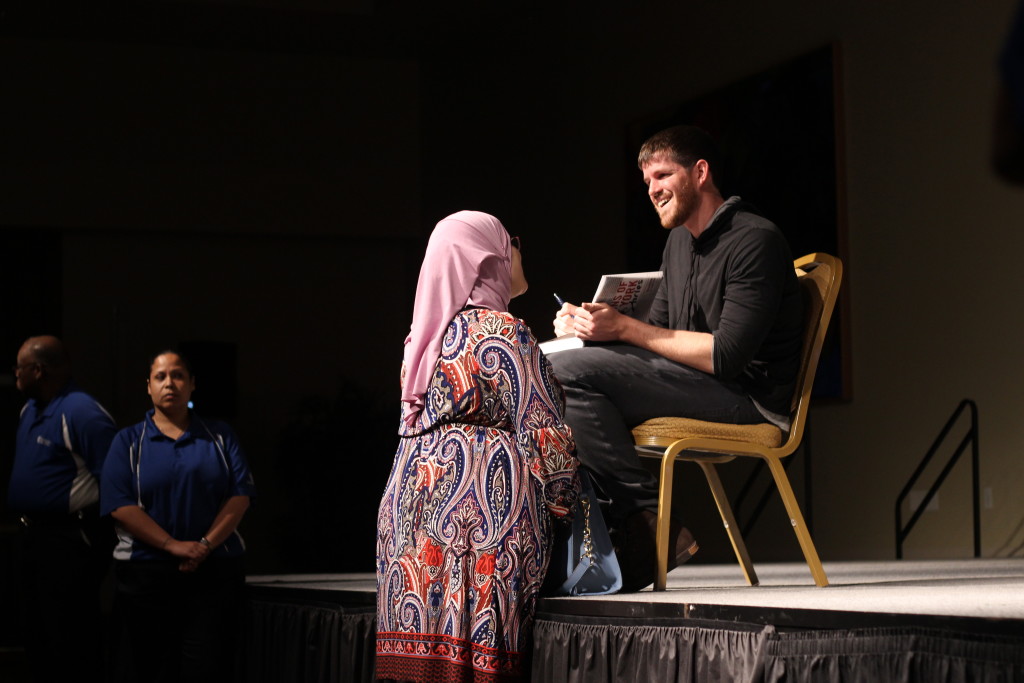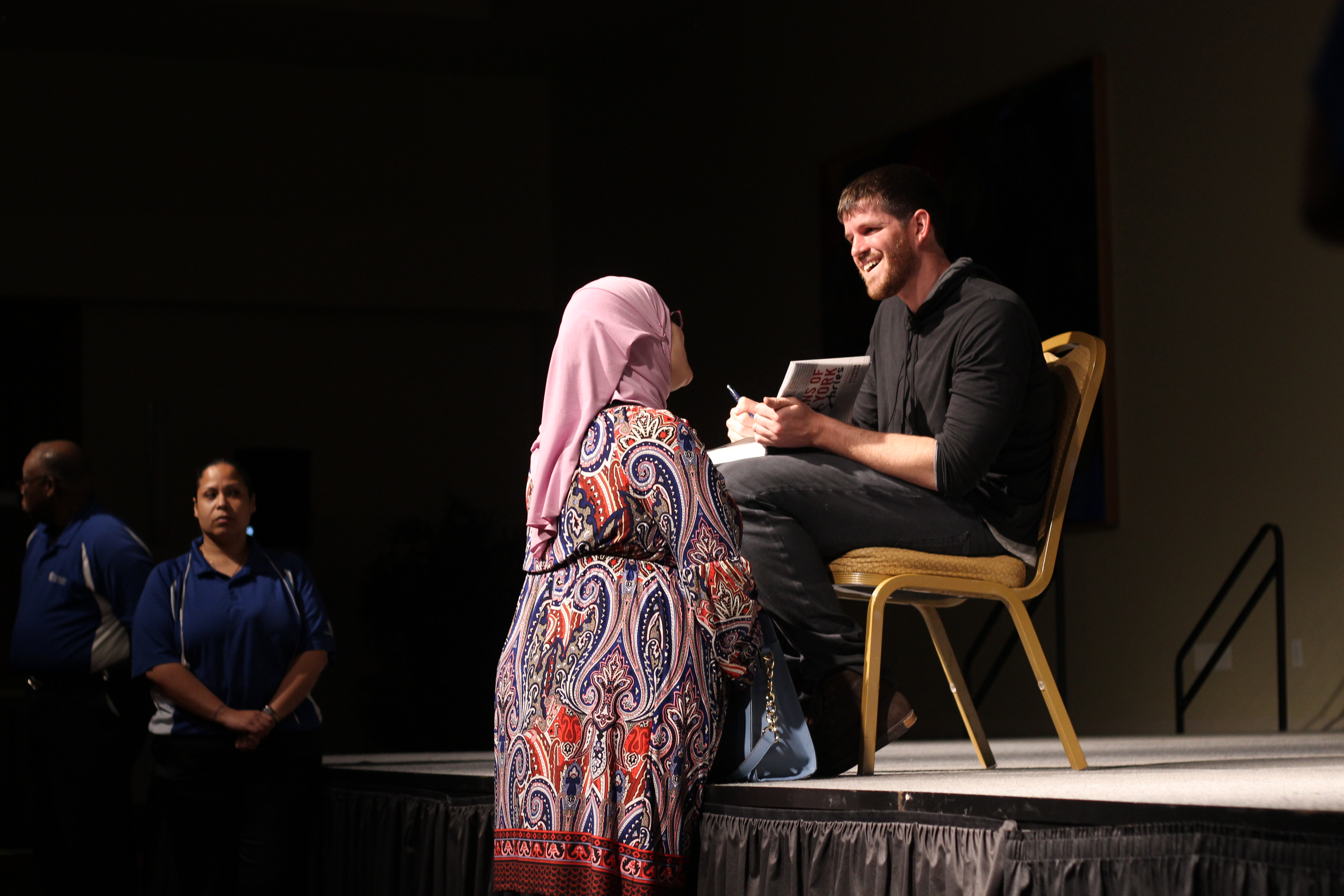…uses photography and storytelling to capture people’s lives and unify strangers around the globe
Brandon Stanton, founder of the successful photo-centric storytelling blog, Humans of New York, said he didn’t pick up a camera until the age of 26.
For anyone who’s familiar with HONY knows how shocking this statement is – and the surprise showed from the wave of silence that fell over the capacity crowd during his lecture at USF Tampa on April 5.
The 32-year-old native of Marietta, Ga., an Atlanta suburb, has built a worldwide phenomenon that has gained over 17 million followers on Facebook and close to 5 million on Instagram, in only six years.

Brandon Stanton, founder of the popular storytelling blog Humans of New York, took questions from the crowd after his lecture at USF Tampa on April 6. Here he signs his book for a fan.
But he made sure to remind the room that it took major failures to find the success.
Stanton majored in history at the University of Georgia – but didn’t graduate the first go-around.
“I ended up flunking out school,” he said to the auditorium of college students. “And I didn’t just flunk out … I flamed out.”
Stanton said he tried to turn things around when he went back to community college and started getting good grades.
Although he did graduate from the University of Georgia in 2008 with a bachelor’s in history, Stanton said finding a job in the field was difficult without a master’s or Ph.D, and later landed a job as a bond trader in Chicago.
But his obsession over keeping the job grew and eventually took over.
“It was all I thought about,” Stanton said. “I could’ve been in the front row of my favorite band at a concert and I would be thinking about the markets for Monday morning.”
Although it was a job in finance, he said he never viewed himself as a money-orientated person.
“I told myself, ‘I’m going to make my money first…I’m going to get some security; I’m going to get it cushioned,” Stanton said. “Then I will do what I love, then I will make a movie, write books or do something creative that I enjoy.”
As time went on, the job consumed him and his plans took the back seat.
Two years later, what Stanton was always worried about happening –happened.
He got fired.
The day, he said, was unexpectedly good.
“I didn’t have to think about it anymore. I could use my mind to decide what I wanted to do; I could do anything,” Stanton said. “I decided that, at least for the foreseeable future, I was going to try to structure my life so I wasn’t using my time to make money, but try and make just enough money to where I was able to control my time…that was the realization.”
Stanton said he bought a camera while he was still a bond trader for stress relief, because he always loved taking photographs.
After he lost his job, Stanton began to photograph everything and anything, sometimes of people, sometimes not.
One day, he got off the subway in Chicago and saw two young boys on the sidewalk with their mothers. Both were looking upward, in the same direction, with the same bewildered expression on their faces and Stanton thought, “I have to capture this.”
He said it was the first time he couldn’t hide in the shadows or across a busy street to get a photo – he had to get up close and interact with strangers.
“It was the most pivotal moment, because I looked down at the screen after I took that photo and I remember feeling such a sense of pride,” Stanton said. “I had only been photographing for about a month at that point, but I took a photo that somebody who had been photographing for 20 years might not be able to get; because it involved getting over that fear of approaching a stranger.”
That was when Stanton said the path that eventually lead to HONY opened up. He knew he loved photography, but realized he could connect to people.
And where do people with big dreams usually go? New York City.
He stepped off the Greyhound bus with his life stuffed in two suitcases, and no money.
After persuading a few friends to buy some of his photos, Stanton gathered enough money to sublease an apartment
But he said he didn’t spend much time there, devoting almost all of it to his photography.

USF student Maria Fuentes reads the “Humans of New York” book next to her friend Irene John while waiting for Brandon Stanton to take the stage for his USF Tampa lecture. Published in 2013, the book sold 30,000 pre-ordered copies and spent almost 30 weeks on the New York Times bestsellers list.
“I didn’t know anyone in New York,” he said. “I never went to bars, movies or concerts; never hung out with friends. All I did was photograph all day long.”
Eventually, Stanton started a human-centric photography blog; and said even after taking thousands of photos, no one was really paying attention, yet.
But he kept at it.
“(I was) obsessively, single-mindedly committed to figuring out a way where I could photograph all day long,” Stanton said. “My belief was, if I kept getting a little bit better and a little bit better, I would finally reach that tipping point where I couldn’t get better, where I had figured it out.”
At the time, he said most of the people who followed his work were friends and family.
“It takes so much work before you find your first fan; your first real fan who doesn’t know who you are, but is passionate about your work just because of your work.”
Stanton said he first realized he might make it when he started seeing names of people he didn’t recognize. Although it began with only a couple of new followers a week, his work was starting to connect with the outside world.
“One or two people a week turned into 10, which turned into 50, which turned into 100,” Stanton said. “I think, at one point over three days, I gained half a million facebook fans.
Though he had taken thousands of portraits at this point, none included the personal stories that HONY is famously known for.
It all came from a photo of a woman on a New York City sidewalk. She was dressed head-to-toe in green, and even had green streaks in her gray hair.
It wasn’t so much the photo, which he thought wasn’t his best anyway, but what she told him that made the encounter stand out.
“This was the first time I did somewhat of an interview,” Stanton said. “But I remembered she told me something, she said, ‘Every day I used to be a different color, but I was green one day…and that was a good day. So I’ve been green for 15 years.’”
He got sick the next day, but still needed to update the blog. Though he didn’t love the photo itself, he loved her quote and decided to add it to the post.
In a matter of hours, Stanton said it became his most engaged with photo – ever.
And from that moment, Humans of New York became the storytelling blog the world knows today.
Stanton has since traveled to 20 different countries, went to prisons and visited the oval office to photograph and interview President Barack Obama.
Humans of New York is constantly evolving, Stanton said, but its core remains the same.
“It’s focused on stopping a stranger on the street and, in a short amount of time, create an atmosphere where they feel comfortable enough to share their story – things they might not have share with their best friend” he said. “And then, tell the story in a way that introduces them to the audience.”
“That’s what Humans of New York is; that bubble on the street. That was what I was searching for and what I finally figured out.”



